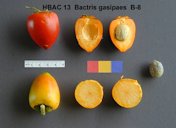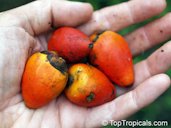| Peach Palm, Pejibaye - Bactris gasipaes | |||||
|---|---|---|---|---|---|
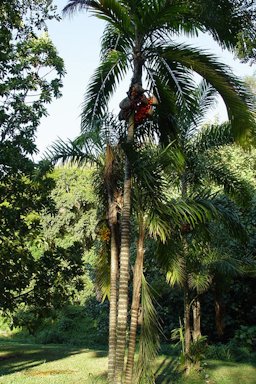 Fig. 1  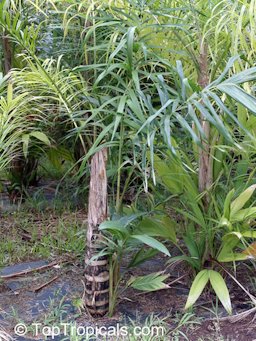 Fig. 2  Peach palm young tree 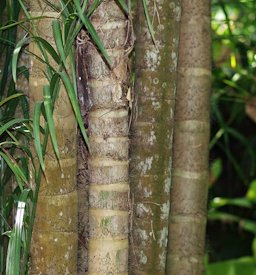 Fig. 3  B. gasipaes stems 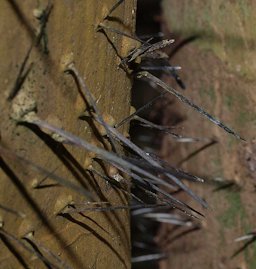 Fig. 4  B. gasipaes stem spines 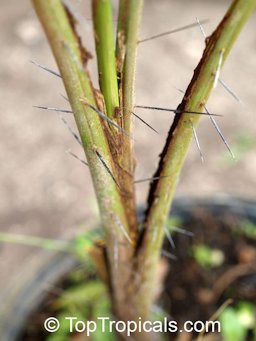 Fig. 5  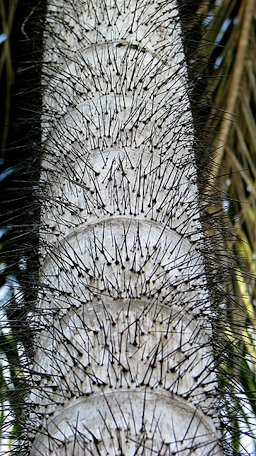 Fig. 6 The spiny stem 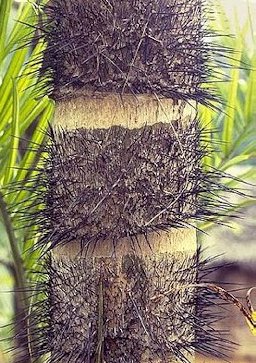 Fig. 7 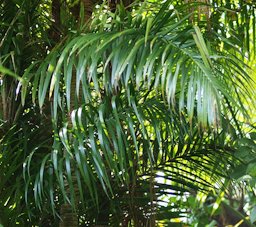 Fig. 8  B. gasipaes leaves 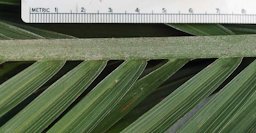 Fig. 9  B. gasipaes abaxial leaf rachis with tomentum 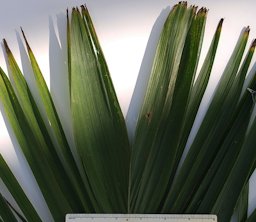 Fig. 10  B. gasipaes abaxial leaflet tips (Note: apical leaflets wider than other leaflets) 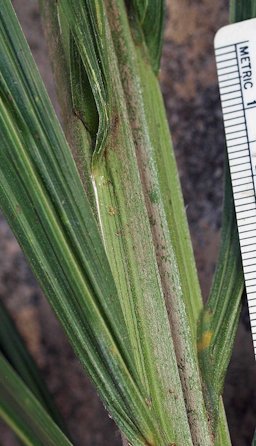 Fig. 11  B. gasipaes adaxial leaf rachis with tomentum 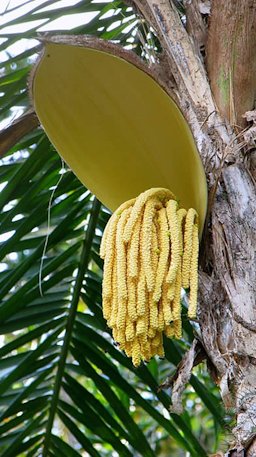 Fig. 12 Peach palm Inflorescense 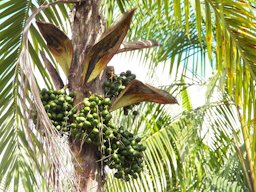 Fig. 13  Pupunheira (B. gasipaes) 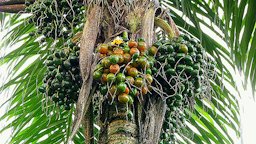 Fig. 14  B. gasipaes, ripening fruit 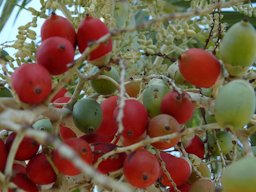 Fig. 15  Edible fruit commonly called parépou in Guianese Créole, B. gasipaes Lake in Kourou, French Guiana (Amazonia) 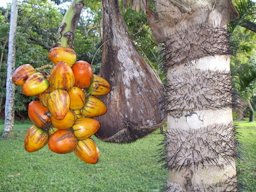 Fig. 16  Ripe fruit 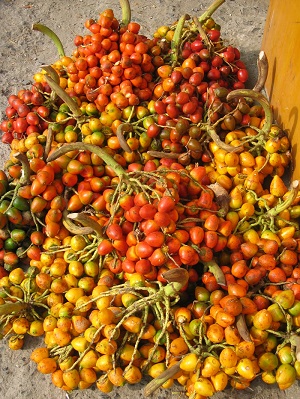 Fig. 17  Harvested fruits 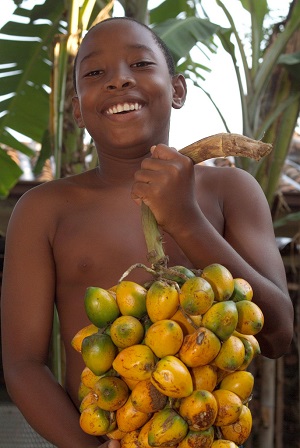 Fig. 20 A boy holding up peach palm, a highly productive fruit plant, flourishing in the district of Rionegro, Colombia 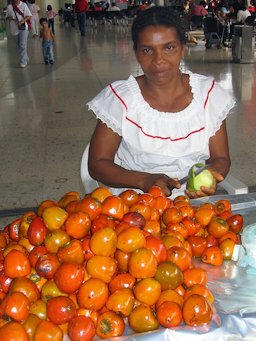 Fig. 21 B. gasipaes sold at Cali Airport (Colombia) 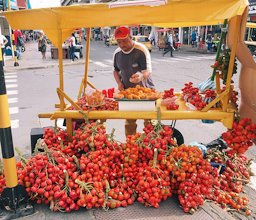 Fig. 22  Seller of chontaduro in the town of Cali, Columbia 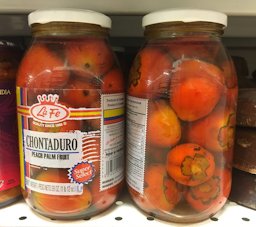 Fig. 23  Chontaduro, B. gasipaes, Publix Supermarket, Boynton Beach, Florida, USA 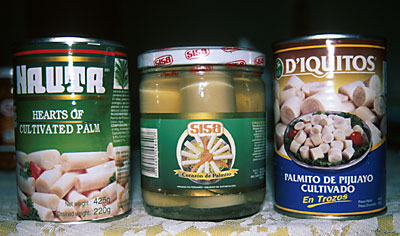 Fig. 24 Peach palm heart 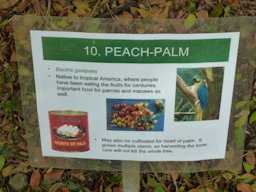 Fig. 25  B. gasipaes, at Ho'omaluhia Botanical Garden in Kaneohe, Hawai'i Back to Edible Palms Fruit Index |
Scientific
name Bactris gasipaes Kunth Pronunciation BAHK-triss gah-ZEE-pehz Common names English: peach-palm; Brazil: pupunha; Bolivia: tembé; Colombia: chontaduro; Costa Rica, Dominican Republic: pejibaye; Ecuador: chonta, chantaduro; Guatemala: manaco; Guyana: awara; Trinidad, Tobago: peewah, Nicaragua, Honduras: pijibay, supa; Panama: pixbae or pivá or pifá; Peru: pijuayo; San Andrés archipelago: cor wary, supa; Venezuela: pijiguao; pibá 4,14 Native American languages: at least 300 names, some of which are variations on pejibaye, gasipaes, or pupunha. 16 Synonyms Bactris gasipaes (Kunth) L.H.Bailey; B. gasipaes var. gasipaes; B. gasipaes var. chichagui (H.Karst.) 3 Relatives Maraja palm (B. maraja), tobago cane (B. guineeneses), Colombian palm (B. major) 1 Family Arecaceae (palm family) Origin Pejibaye in the Amazonian regions of Colombia, Ecuador, Peru, and Brazil but has become naturalized throughout Central America 1 USDA hardiness zones 10b-11 Uses Specimen tree; edible fruit/heart of palm Height 65-100 ft (20-31 m). Spread 10-13 fronds Crown Full and almost round 18 Plant habit Multiple stems (trunks); clumping growth habit 1 Growth rate Rapid, reaches 43 ft (13 m) in 10-15 years Longevity Long-lived perennial plant productive during 50-75 years Trunk/bark/branches Armed with stiff, black spines in circular rows (there are spineless forms) Pruning requirement One pejibaye clump may be utilized for both heart of palm (cutting young palms out) and for fruit from mature suckers 1 Leaves Pinnate; many linear, pointed leaflets; leaf veins covered with short spines; green to dark green 1 Flowers From leaf axils; in a spathe; yellowish male and female flowers; terminal flowers are all male 1 Fruit A drupe yellow to red, turning purplish when ripe; pulp may be yellow to light-orange; sweet; dry and mealy 1 Heart of palm (palmito) The central white, soft core of young pejibaye stems is edible 1 Season Sept.- Dec.; highest yields obtained in Oct.- Nov. 11 Light requirement Full Sun Soil tolerances Well-adapted to most well-drained soils but grows best in moderately fertile soils 1 Drought tolerance Moderate; tolerates waterlogging 11 Soil salt tolerance Low pH preference 6.5-7.7 11 Cold tolerance Young shoots will be killed at 25-27 °F (-3 to -4 °C) Plant spacing 15-20 ft (5-6 m) for fruit production; 6.5 x 3 ft (2 m x 1 m) for palm heart production 15 Invasive potential * None reported Pest resistance There are fruit and trunk diseases as well as some insects Roots Extensive but fairly superficial 4 Known hazard Dangerous spines; spines from the first 5-8 ft (1.5-2.4 m) of trunk may be removed for safety 1 The fruit is caustic in its natural state 3 Reading Material Pejibaye (Peach Palm) Growing in the Florida Landscape, University of Florida pdf Pejibaye, Fruits of Warm Climates Pejibaye, Neglected Crops, Food And Agriculture Organization of the United Nations Bactris gasipaes, PROSEA Foundation Bactris gasipaes, Handbook of Energy Crops Peach Palm (Bactris gasipaes Kunth.): Ancestral Tropical Staple with Future Potential, Plants pdf Origin A pre-Columbian staple, Bactris gasipaes Kunth. is a palm tree domesticated around 4000 years ago, so appreciated that a Spanish chronicler wrote in 1545, “only their wives and children were held in higher regard” by the Mesoamerican natives. The peach palm is an integral part of the foodways and gastronomy of Ecuador, Colombia, Bolivia, Peru, Brazil, and other tropical American countries; meanwhile, it is almost unknown in the rest of the world, except for hearts of palm. 10 B. gasipaes currently extends throughout the Amazon basin and other humid lowlands of the neotropics, with one population up to 1800 m above sea level in Colombia. The species has been introduced to countries such as Australia, Indonesia, Malaysia, Reunion island, and Hawai'i to relieve the pressure on local palms endangered by non- sustainable production, especially where hearts of palm are produced. 10 Pejibaye was introduced into the U.S. in 1920, the Philippines in 1924, and India during the 1970s. 1 Description Pejibaye is a suckering palm. A few months after germination the first lateral shoot may already appear at the base of the plant, so that eventually a tight cluster of reproductive stems is formed. It is not clear how the palm divides its energy between fruiting and suckering. 15 The palm is erect, with a single slender stem or, more often, several stems to 8 in. (20 cm) thick, in a cluster; generally armed with stiff, black spines 2-4.75 in. (5–12 cm) long, densely spaced occurring on 70–99% of trunks, growing in annular bands 2-6 in. (5–16 cm) wide between the places of attachment of the petioles to the trunk; about 0.5% of pejibaye trunks in Costa Rica are virtually spineless. The pejibaye usually produces suckers freely. 2,11 Growing habit It has a unique growth habit in which one seedling tends to form clumps of trunks. Solitary trunks are seldom seen. Each trunk is erect and reaches a mature height of 40-65 ft (12-20 m) and a basal diameter of 8-12 in. (20-30 cm). As each frond dies, scars are left leaving the trunk marked with rings. Up to 3 or 4 trunks can reach maturity at the same time. A big drawback is the large sharp black spines growing perpendicularly from the trunk. These 3 in. (8 cm) long spines are arranged in circular zones of varying width. Those near the base of the stem are four to six inches wide, while those higher up decrease in width from one to two inches. Between the zones of thorns is about an inch (3 cm) of smooth trunk. 7 Typically, there are 10-13 fronds per palm. Suckers emerge during the first 5 years. Old palms may also produce suckers from the stump after felling. Usually about 8 offshoots are produced on a palm with a maximum of 18 of which 2-4 are normally allowed to develop. 12 Leaves Leaves up to 6.5 ft (2 m) long, dark green above, light green beneath, arranged about 110° apart around the trunk, midrib with short firm spines in 3 longitudinal stripes on its lower surface, especially near the basal attachment, a new leaf being produced every 2–4 weeks, depending upon the vigor of the tree and the seasonal climate. 11 The leaf stalks (petioles) are about 1 m long. The leaf is 3 m long and is curved with numerous leaflets which arise in several planes from the upper two thirds of the leaf stem. The crown is full and almost round. The leaves have a characteristic sway in the breeze. 17 Flowers The inflorescence emerges from leaf axils, is enclosed in a spathe, and is composed of racemes 8-12 in. long (20-31 cm). The racemes possess yellowish male and female flowers; terminal flowers are all male. Flowers are mostly insect pollinated, and cross pollination among plants improves fruit set. 1 The peach-palm is a monoecious plant with male and female flowers mixed on the rachillae. It is also protogynous, since the female flowers are fertile as from the opening of the spathe and continue to be receptive for 24 hours. Anthesis of the male flowers occurs on the second day of the cycle, i.e. 24 hours after the females. 4 The palms flower twice a year. If sufficient moisture is available during growing season, two crops a year may be obtained. 11 Fruit The edible fruit hangs in clusters of 50 to 300 fruit and may weight 25 lbs (11.4 kg). There may be up to 5 clusters of fruit on a plant at a time. The time from flowering to fruit harvest is about 8 to 9 months. The fruit is a drupe and is yellow to orange to scarlet or brownish, turning purplish when fully ripe. The fruit may be oval or round, 1 to 2 inches in diameter, with a 3-pointed calyx at the stem end. The peel is thin. The pulp may be yellow to light-orange, sweet, dry and mealy, fruit usually contain only 1 black seed enlcosed in a thin endocarp. Some fruit are seedless. 1 Seedless varieties have low fiber content in the pulp, a strong skin, easy to peel, low water content, a firm dry texture, a high oil content for good flavor and non-powdery texture and a skin that develops superficial cracks considered a mark of good quality. 11 The first bunches are produced within 3—4 years after planting. 15
Fig. 18. Palm Heart (palmito) This 'heart' is the still folded young leaves within the growing tip of the trunk. It is usually used fresh, cooked or canned. When raw or cooked it is used mainly as a salad ingredient. It keeps its appearance, texture and flavour very well. 7 Varieties There is much variation in form, size, color and quality of the fruits. Some with longitudinal scars (pejibaye rayodo) are considered of superior quality. These scars indicate low water content, firmness and a minimum of fiber in the flesh. In Costa Rica there are palms that bear clusters having a majority of seedless fruits. These are called pejibaye macho (male pejibaye) and are much prized. 2 Harvesting Peach palm generally produces its first fruit crop in 3-5 years, and may produce one or two crops annually. They may produce annual fruit crops for 50-75 years. Inflorescences develop in sequence on the stem, so one cannot harvest all fruit bunches on the stem at the same time. 6 A fruit cluster may contain 75 to 300 fruits and weigh 26.5 pds (12 kg). Each trunk produces about 7 bunches at the principal harvest and 3 at a secondary harvest. Since 4 or 5 trunks are generally permitted to grow from each clump, the average yield is about 198 pds (90 kg) per year. 11 Ripe fruit has poor keeping qualities as mold sets in after 3–5 days. 11 The palm shoots are harvested before they reach 3 in. (7.5 cm) around the base. Pollination The pollination cycle takes place over three days and consists of three complementary methods. The first is entomophilous (insect pollinated) and is the most important. The second pollination method is by gravity. When the pollen is released during the second day, it completely covers the inflorescence and, in doing so, covers its female flowers. The third method is anemophilous (pollen distributed by wind), occurring between adjacent plants during the morning of the second receptive day of the female flowers. 4 The controlled pollination technique consists of protecting the inflorescence from the sight of curculionids, using well-fitting bags of kraft paper and applying the pollen on the day following the opening of the spathe. It is not necessary to emasculate the male flowers. 4 Propagation Pejibaye may be propagated by seed or suckers. Fruit quality of pejibaye propagated by seed varies widely. Superior plants must be propagated by suckers. 1 Pejibaye seeds take 60 to 90 days to germinate. Prior to planting thoroughly wash the seed and dip it into a fungicide to seed-rotting fungi. Slightly bury the seed in a well-drained media, cover the container with a plastic bag to increase the relative humidity, and place the container in a warm but shaded location. Well-grown seedlings will be ready for planting out-of-doors after 6 months. Seedlings grow rapidly, and after 21 to 27 months or more the trunk begins to form. Under favorable climatic and cultural conditions the palm has 15 to 25 leaves. Seedling trees may begin to bear fruit after 3 to 4 years. 1 Seed should be obtained from plants selected for desirable fruit characteristics, high yield and spinelessness. 5 Planting Pejibaye may be planted as part of the landscape but its clumping growth habit and dangerous spines must be taken into account; therefore this palm should be grown away from areas where people frequently walk or play. Pruning Pejibaye is a clumping palm. Young palm shoots are harvested for heart of palm (called palmito). Pejibaye used for palm fruits is allowed to grow to maturity. Usually only 1 or 2 shoots are allowed to grow to maturity and any new shoots are eliminated. 1 If all the spines are cut off the spiny trunks, the palm will die, but 5-8 ft (1.5 2.5 m) of trunk can be despined safely. 2 Fertilizing Young palm trees should receive ¼ to ½ pound (113 to 226 g) of a mixed fertilizer containing nitrogen (N), phosphate (P2O5), potash (K2O), and magnesium (Mg) 2 to 3 times during the growing season. As trees mature, the fertilizer rate should increase to 1 to 2 lbs (0.45 to 0.9 kg) with an application frequency of 2 to 4 times per year. Fertilizer mixtures containing 6-8% nitrogen, 2-4% available phosphoric acid, 6-12% potash and 3-4% magnesium are satisfactory. 1 Irrigation Pejibaye palm trees need about 4-6 inches (10.2-15.2 cm) of water per month for normal growth and production. Thus about 1-1.5 inches (2.5-4 cm) of water should be applied per week from April through October (the warm to hot period during the year) if it does not rain enough, and during warm, dry periods in the late fall and early winter months. 1 Pests Insect pests include the sugar cane weevil and mites. Silky Cane Weevil, Metamasius hemipterus sericeus, University of Florida pdf Diseases The trunk of pejibaye is susceptible to attack by Phytophthora algae. Leaves may be attacked by Pestalotiopsis sp., Mycosphaerella sp. and Colletotrichum sp. Fruit diseases are caused by Monilia sp. and Ceratocystis species. Please contact your local County Cooperative Extension Agent for current control recommendations. 1 Pestalotiopsis (Pestalotia) Diseases of Palm, University of Florida pdf Food Uses The uses of the starchy fruit resemble those of cassava. The fruit becomes edible after boiling in salted water. The lightly cooked fruit is dried and stored for 6 months or longer, after which it can be reconstituted by further boiling. 15 Fruit should be boiled within 2 to 4 days of harvest. Before consumption, the fruit is boiled for about 1 to 3 hours to eliminate oxalate crystals and a trypsin inhibitor. Then, the peel is removed and the pulp eaten. The flavor varies with the carotenoid content and may be bland to a nutty or strong flavor. The pulp may be dipped in mayonnaise or cheese-dip. Pejibaye pulp may also be mixed with cornmeal, eggs, and milk and fried. Raw fruits may be kept for several weeks in a cool, dry place and cooked fruits may be held in the refrigerator for 5 or 6 days. 1 Young flowers may be chopped and added to omelettes. The cooked seeds are eaten like chestnuts but are hard and considered difficult to digest. 2 Palmito or palm heart (Fig. 24), a gourmet vegetable with an expanding world market, is the only pejibaye product currently grown on a commercial scale. The apical and basal residue from palmito extraction also have potential use. The basal residue just below the apical meristem, is very tender and has a crispy texture. This could be made into cream soup or be thin-sliced (transversally) as a substitute for bamboo shoots, or deep fried to make chips. The apical residue is slightly fibrous leaf and petiole material, which can be used as a vegetable. 5 Nutrient Content The edible portion ranging from 40—98% of fruit weight; commonly it is 85—95%. Moisture content (25—82%, usually 50% or more), carbohydrates (14—85% of dry weight) and oil content (2—62% of dry weight) are major variables, leading to a useful distinction in starchy and oily fruit types. Protein content (3—18% of dry weight, usually about 6%) is high enough to balance the nutritive value of the fruit; of the 8 essential amino-acids only tryptophane is lacking. If the fruit flesh has a deep orange or yellow colour, it is rich in carotene; the content ranges from 0 to 0.002 oz (0 to 70 mg) per 3.5 oz (100 g) fresh pulp. 15 Per 100 g, the fruit is reported to contain 196 calories, 50.5 g H2O, 2.6 g protein, 4.4 g fat, 41.7 g total carbohydrate, 1.0 g fiber, 0.8 g ash, 14 mg Ca, 46 mg P, 1.0 mg Fe, 1346 mg b-carotene equivalent, 0.05 mg thiamine, 0.16 mg riboflavin, 1.4 mg niacin, and 35 mg ascorbic acid. 5 Other Uses An oil is obtained from the seed. This species may turn out to be a better economic option than most other American oil palms. Oil levels of up to 62% of the dry weight have been reported, and there are reports that a large pot of boiling fruit can produce 70.5-105.8 oz (2-3 kg) of oil. The oil separates easily when the fruits are cooked. As with other palms, it is a potential source of lauric oils. The seed is rich in saturated fatty acids, and could be used to manufacture cosmetics and soap. 8 Cutting off too many spines can kill the palm. The Amazonian Indian used these spines as needles. The trunk of the palm consists of a black hard wood which resists water, termites and other insects. It polishes well and was used as bow and spear shafts by the Indians. The wood is also made into handles, yokes, ornaments and furniture. 7 Hollowed out trunks serve as water troughs or conduits, or as flower planters. 11 The wood is used to manufacture building materials such as parquet, panels, luxury furniture and handicraft items, taking advantage of its beauty and great strength. The long fibres on the inside of the trunk show promise for use in fibrecement products. 4 General This palm is the basis for a commercial (non-destructive) heart-of-palm industry in Central and South America. 9 Prolonged fermentation - lasting one week - enabled the alcoholic drink, chicha to be made for celebrating festive occasions. Thus, the fruit of each palm constituted a basic source of energy, replacing the functions and uses of grain in other cultures. It was especially significant as a substitute for maize, which it surpasses in nutritional value. 13 Further Reading Pejibaye, New Crop FactSHEET, Purdue University Peach palm, International Plant Genetic Resources Institute pdf The Pejibaye (Peach Palm), Archives of the Rare Fruit Council of Australia Peach palm (Bactris gasipaes) in tropical Latin America: implications for biodiversity conservation, natural resource management and human nutrition, Biodiversity International pdf The Pejibaye, the Neglected Palm, Archives of the Rare Fruit Council of Australia List of Growers and Vendors |
||||
| Bibliography 1 Crane, Jonathan H. "Pejibaye (Peach Palm) Growing in the Florida Home Landscape." Horticultural Sciences Dept., UF/IFAS Extension, HS1072, Original Pub. Feb. 2006, Revised Nov. 2016, Reviewed Dec. 2019, AskIFAS, edis.ifas.ufl.edu/HS312. Accessed 26 Apr. 2017, 4 Oct. 2023. 2 Fruits of Warm Climates. Julia F. Morton, Miami, 1987. 3 "Bactric gasipaes Kunth." Plants of the World Online, Facilitated by the Royal Botanic Gardens, POWO, (CC BY 3.0), powo.science.kew.org/taxon/urn:lsid:ipni.org:names:28453-2. Accessed 29 Nov. 2023. 4 Mora-Urpi, J. "Peach-palm (Bactris gasipaes)." Neglected crops: 1492 from a different perspective, pp. 211-221, Food and Agriculture Organization of the United Nations, 1994, FAO, www.fao.org. Accessed 26 Nov. 2015. 5 Duke, James A. "Bactris gasipaes H.B.K." Handbook of Energy Crops, Purdue University, Center for New Crops and Plant Products, unpublished, 1983, NewCROPTM, hort.purdue.edu/newcrop/duke_energy/Bactris_gasipaes.html. Accessed 4 Oct. 2023. 6 Mora-Urpí, et al. "Peach palm. Bactris gasipaes Kunth. Promoting the conservation and use of underutilized and neglected crops. 20." Institute of Plant Genetics and Crop Plant Research, Gatersleben/International PlantGenetic Resources Institute, Rome, Italy, 1997, www.fao.org. Accessed 2 Dec. 2015. 7 Oram, Ann. "The Pejibaye, the Neglected Palm." Archives of the Rare Fruit Council of Australia, Nov. 1987, rfcarchives.org.au. Accessed 4 Dec. 2015. 8 World Agroforestry Center, www.worldagroforestry.org. Accessed 5 Dec. 2015. 9 Haynes, Jody and, John McLaughlin. "Edible Palms and Their Uses." Horticultural Sciences Dept., UF/IFAS Extension Miami-Dade, First pub. Nov. 2000, MDCE-00-5, AskIFAS, edis.ifas.ufl.edu. Accessed 14 Dec. 2015 10 González-Jaramillo, N., et al. "Peach Palm (Bactris gasipaes Kunth.): Ancestral Tropical Staple with Future Potential." Plants, 2022, (CC BY 4.0), doi.org/10.3390/plants11223134. Accessed 4 Oct. 2023. 11 Duke, James A. "Bactris gasipaes H.B.K." Handbook of Energy Crops, Purdue University, Center for New Crops and Plant Products, unpublished, 1983, NewCROPTM, hort.purdue.edu/newcrop/duke_energy/Bactris_gasipaes.html. Accessed 4 Oct. 2023. 12 Pareek, Om Prakash, and Suneel Sharma. "Underutilized Fruits and Nuts Vol.2: Fruits of tropical region." EPDF, epdf.pub/underutilized-fruits-and-nuts-vol2-fruits-of-tropical-region.html. Accessed 17 Nov. 2023. 13 "Pejibaye." Recipes Wiki, (CC BY-SA), recipes.fandom.com/wiki/Pejibaye. Accessed 17 Nov. 2023. 14 "Bactris gasipaes." Wikipedia, en.wikipedia.org/wiki/Bactris_gasipaes. Accessed 29 Nov. 2023. 15 Mogea, J. P., and E. W. M Verheij. "Bactris gasipaes Kunth." Plant Resources of South-East Asia, no. 2: Edible fruits and nuts, 1991, (CC BY-SA 3.0), prosea.prota4u.org/view.aspx?id=1481. Accessed 1 Dec. 2023. 16 Clement, Charles R. "Pejibaye." New Crop FactSHEET, NewCROP TM, hort.purdue.edu/newcrop/CropFactSheets/Pejibaye. Accessed 1 Dec. 2023. 17 Darley, James J. "Pejibaye (Peach Palm)." Archives of the Rare Fruit Council of Australia, Nov. 1983, rfcarchives.org.au. Accessed 5 Dec. 2015. Photographs Fig. 1 Edric. "Bactris gasipaes." Palmpedia, 2007, palmpedia.net/wiki/Bactris_gasipaes. Accessed 6 Dec. 2015. Fig. 2,5,19 "Peach Palm, Pixbae, Pewa." Top Tropicals, toptropicals.com. Accessed 28 Mar. 2014. Fig. 7,16,22,24 Edric. "Bactris gasipaes." Palmpedia, 2012, palmpedia.net/wiki/Bactris_gasipaes. Accessed 6 Dec. 2015. Fig. 3,4,8,9,10,11 Anderson, P. J. "Bactris gasipaes." Identifying Commonly Cultivated Palms, In A Resource for Pests and Diseases of Cultivated Palms, Florida Department of Agriculture and Consumer Service, Division of Plant Industry and Identification Technology Program, CPHST, PPQ, APHIS, USDA; Fort Collins, CO, 2011, idtools.org/id/palms/palmid. Accessed 6 Dec. 2015. Fig. 6,12,14 Popovkin, Alex. "Bactris gasipaes, Entre Rios, Bahia, Brazil." Wikimedia Commons, 2008, commons.wikimedia.org. Accessed 27 Mar. 2014. Fig. 13 Marajonida. "Cacho de pupunha ainda verde." Wikimedia Commons, 2015, (CC BY-SA 3.0), commons.wikimedia.org. Accessed 5 Dec. 2015. Fig. 15 Marialadouce. "Edible fruit commonly called parépou in Guianese Créole. Bactris gasipaes." Wikimedia Commons, 2006, (CC BY 2.5), commons.wikimedia.org. Accessed 27 Mar. 2014. Fig. 17 Hermann, Michael. "Harvested Fruits." The Tropical Plants Database, (CC BY-SA 3.0), tropical.theferns.info. Accessed 5 Dec. 2015. Fig. 18 "Bactris gasipaes." U.S. Department of Agriculture, Public Domain, www.ars.usda.gov/ARSUserFiles/20400510/peachpalm/HBAC13FR.jpg. Accessed 17 Nov. 2023. Fig. 20 Camacho, A. "A boy holding up peach palm, a highly productive fruit plant, flourishing in the district of Rionegro, Colombia." Biodiversity International, (CC BY-NC-ND 2.0), bioversityinternational.org. Accessed 27 Nov. 2015. Fig. 21 Hermann, Michael. "Bactris gasipaes sold at Cali Airport (Colombia)." Wikipedia, Crops for the Future, 23 Dec, 2004, (CC BY-SA 3.0) en.wikipedia.org/wiki/Bactris_gasipaes. Accessed 29 Nov. 2023. Fig. 22 ElizabethJamesBishop. "Temporada de chontaduro en la ciudad de Cali." Wikimedia Commons, 6 Mar. 2019, (CC BY-SA 4.0), image cropped, commons.wikimedia.org/wiki/File:Temporada_de_Chontaduro_en_Cali.jpg. Accessed 2 Dec. 2023. Fig. 23 Zona, Scott. "Chontaduro, Bactris gasipaes, Publix Supermarket, Boynton Beach, Florida, USA." Flickr, 29 Mar. 2019, (CC BY-NC 2.0), Image cropped, www.flickr.com/search/?text=Bactris%20gasipaes. Accessed 1 Dec. 2023. Fig. 24 Cutler, Wendy. "Bactris gasipaes, at Ho'omaluhia Botanical Garden in Kaneohe, Hawai'i." Flickr, 7 Jan. 2013, (CC BY 2.0), www.flickr.com/photos/wlcutler/8357297992/. Accessed 1 Dec. 2023. * UF/IFAS Assessment of Non-native Plants in Florida's Natural Areas Published 19 Apr. 2014 LR. Last update 2 Dec. 2023 LR |
|||||
